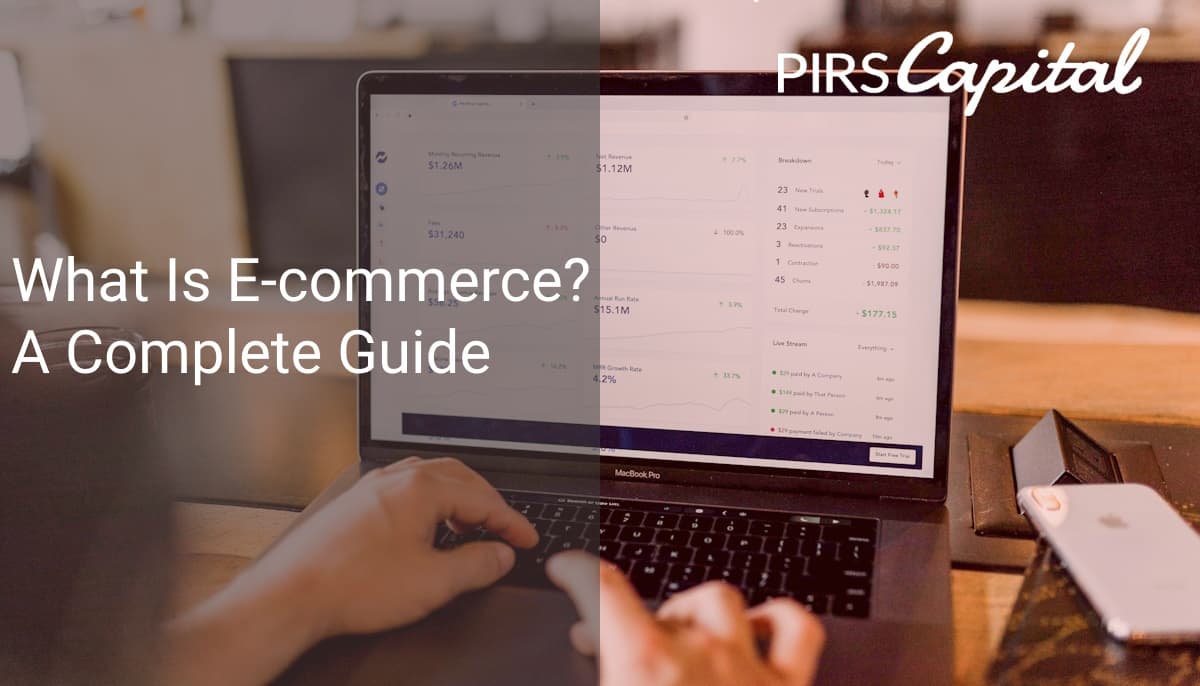E-commerce, or electronic commerce, is a digital platform for businesses to sell and buy products and services online. Funds and data transactions are also completed over an electronic network.
Business owners utilize different online marketplaces to launch their goods and services, in which customers can freely select and purchase products. These web stores have servers that directly manage purchases and payments between the seller and the buyer.
In 2021, e-retail purchases reached USD 5.2 trillion and were expected to reach approximately USD 8 trillion by 2026. This shows that the e-commerce economy continues to grow, and more businesses are expanding their market through online links.

How Does E-commerce Work?
Have you ever visited a mall and noticed plenty of products being sold around? We have gadget stores, appliance centers, clothing, beauty salons, grocery stores, etc. Try to put everything online. That’s how e-commerce works!
From the traditional buying of items in a physical store, e-commerce provides a new space for businesses to sell products and services. Instead of building infrastructure, business owners create their websites where all store items are displayed. Customers can browse through their mobile phones and make payments using bank transactions.
After learning the e-commerce meaning and how it works, we can now discuss the type of models, examples, platforms, and vendors that are all essential in the industry.
Types of E-commerce Models
Here are the different types of e-commerce models:
Business to Business
It refers to the selling of products and other services between businesses. Buyers often purchase wholesale and sell it in retail to customers. A United State reseller tracking service reports total sales of $65.4 billion in 2022, with a 10% increase from the previous year.
Business to Consumer
It is known as the retail selling and buying of products in e-commerce. Certain businesses sell their products, services, and information to direct customers. The global market for Business to Consumer E-commerce reached an estimated USD 4.3 million in sales in 2022.
Consumer to Consumer
This type of e-commerce deals with consumers trading products and services. Third parties usually carry out transactions using online platforms to ensure a safe and fair trade.
Consumer to Business
Opposite to Business to Consumer, consumers sell their products and services for businesses through bidding and wholesale purchases. For instance, a social media influencer offers services to promote a business online in exchange for a fee.
Business to Administration
Transactions are done between a business and the administration or a government agency. Various agencies avail e-services such as social security, employment, registers, and legal documents.
Consumer to Administration
Administrations often purchase services for individual customers in e-commerce. Consumers run errands such as making payments, distributing information, collecting taxes, and making appointments on behalf of public agencies.
E-commerce Platforms and Vendors
An e-commerce platform is a software solution for small businesses to large enterprises in marketing their products. It offers services in e-commerce website building, inventory management systems, customer service, and accounting.
Examples of vendors with platforms to manage e-commerce businesses are:
WooCommerce
WooCommerce has a variety of extensions for automated tax calculations, product and order management, marketing integrations, shipping, and other related services. The platform also offers developers you can hire to help you customize your web store. Your store can accept payments on different credit cards, checks, cash, and bank transfers.
With a 36.68% market share, WooCommerce is the number one leading e-commerce platform in 2022.
Wix Stores
This platform has a tool that automatically builds your web store. It has a friendly interface where your dashboard shows the total sales, transactions, and revenue of your e-business.
It includes payment through Wix Payments, credit and debit cards, and PayPal.
Shopify
Shopify’s advantages over other e-commerce platforms are advanced analytics services, special carrier service prices, and a shipping management system. This avenue has 3D Secure checkouts for data protection which makes it one of the best-known e-commerce platforms.
You don’t need design skills to navigate this software. It has an interface that is easy to collaborate with, and you have complete control of the layout and content of your web store. It can accept payment through Visa, Mastercard, American Express, Apple Pay, and Google.
BigCommerce
This platform has high-quality SEO, email marketing features, and an order management system with inventory tools. BigCommerce also has an open SaaS (software as a service) solution, software delivery, and licensing method that gives you faster customization and enterprise integration.
Payments are settled through Amazon Pay, Apple Pay, and Google Pay.
PrestaShop
PrestaShop offers around 2000 choices of templates that you can use to customize your business layout. Its dashboard contains all data from total orders and sales, cart value, profit, and conversion rate. In-store payment, Visa, PayPal, and MasterCard are the available mode of payment for this e-commerce platform.
You will need funds to purchase your own business space on these e-commerce platforms. It is a good thing PIRS Capital offers funding services through our Marketplace Financing Program. Visit our page to know more.
See Also:
Examples of E-commerce
E-commerce is involved in various business transactions. Here are some examples.
Wholesale
Purchase of business goods in bulk, often from a manufacturer to a retailer. The retailer then sells the product in smaller quantities at a higher price to individual consumers.
A wholesaler can focus on selling a single product or offer different goods, depending on their style of market.
Retail
Retailing is an example of e-commerce that focuses on satisfying the needs of final consumers in the food chain. It’s from the French word “re-tailler” which means to divide. Thus, retailing in e-commerce means selling goods in small quantities.
Retail also covers the sale of services to individual customers, such as in health centers, tailoring, and beauty salons.
Crowdfunding
This example targets specific investors and entrepreneurs to fund a new business. There are regulations in crowdfunding that binds investors and business owners to protect their principal.
Dropshipping
Dropshipping is a type of business where a seller acts as a middleman between the manufacturer and the customer. The seller arranges transactions, and inventories are done by wholesalers or manufacturers.
Products and Services
E-commerce products and services come in different forms, including services and physical and digital products. Physical goods are tangible and require order inventory and shipping to consumers. Digital products are online licenses such as courses, templates, and media materials. Meanwhile, services are skills provided by entrepreneurs in exchange for fees.
What Is E-commerce, and How Does It Work?
Electronic Commerce Meaning
It is an online platform that provides an easier way for sellers and buyers to purchase items.
How It Works
Let’s say you want to buy a beauty item in an online shop. You navigate through your computer and find an online market that sells your item. Once you click the order button, your web server then communicates from the order manager down to the stock database to check and confirm your purchase.
Once ready, you will be directed to a merchant system that processes your bank payments. If the transaction is successful, the order manager then requests the manufacturer to dispatch your item, which will be delivered through your door.
Is E-commerce Profitable?
Did you know that e-commerce sales in 2021 accounted for approximately 19% of retail sales worldwide? In other words, the e-commerce space is rapidly increasing. And yes, it is profitable!
The profitability of e-commerce businesses depends mainly on how you maximize the marketplace and how fast you can deliver items. The best way to earn big in e-commerce is to learn your customers’ demands and behaviors toward purchasing goods online.
Why Is E-commerce So Important?
E-commerce allows businesses to expand in the global market without the need to build physical stores and infrastructures. It has several benefits, including:
Exposure to a Wider Audience
E-commerce helps sellers to reach out to customers worldwide. It goes beyond the concept of physical stores in particular locations that certain groups of people can only visit.
Ease of Use
E-commerce describes the use of web stores as more accessible tools than traditional shops. It allows both sellers and buyers to conveniently make purchases. Customers are more interested in shopping online than driving to an actual store and making purchases.
Increased Sales
One good thing about e-commerce is providing opportunities for business owners to increase their sales and revenue.
How Do I Get Started in E-commerce?
First, research and define the e-commerce business that you want to start. Plan your target market and product ideas before creating your online store. Registering your e-commerce business and brand name is also essential to ensure your business’s validity.
Starting up a new e-commerce business is expensive. You can ask entrepreneurs and investors to help with your starting expenses. PIRS Capital also offers e-commerce business funding services. We can help you build your online store through our Marketplace Financing Program. Check out our page to know more about this.
Ready to Get Started?
It is indeed rewarding to watch a business grow and reach the world market. E-commerce has helped thousands of companies build their digital stores and present their products online. It has also provided convenience to millions of customers by buying items and delivering them right through their doors.
Through the years, e-commerce has been transforming the supply chain practices and distribution channels of more businesses into digital networks. So, if you’re planning to contribute to the e-commerce economy, now is the right time to do it. If you need funding to launch your business, reach out to PIRS Capital today.

I work with companies that sell products on platforms such as Amazon, Shopify, Walmart, Ebay, Etsy, etc. I understand that every business is unique and thats why I form genuine relationships with owners so I can help them reach their goals and find success through our working capital solutions.
